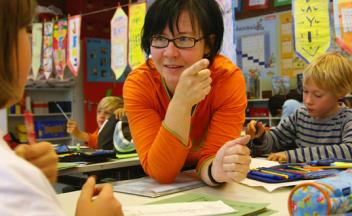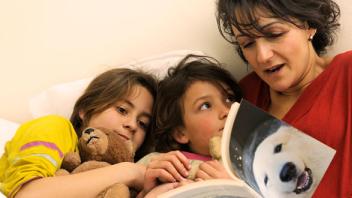What is text structure?
Text structure refers to the way authors organize information in text.
Text structure is the “skeleton” that gives a “shape” and organizes the ideas within a text. Understanding how a text is organized makes it easier to understand the author’s meaning — and helps students focus attention on key concepts and relationships, anticipate what is to come, monitor their comprehension as they read, and summarize the central ideas. Understanding text structure also helps students with their own writing.
Text structures can be taught by showing students examples of different text structures, using graphic organizers, and by teaching signal words that are clues to the structures.
The 5 common text structures
Here are the most common text structures that young readers will encounter:
- Description
- Cause and Effect
- Compare and Contrast
- Chronology/Sequence
- Problem and Solution
Text signals
Text signals are clues to identifying the structure in a text — words or phrases that indicate what kind of text structure a reader will encounter as they read. This can help readers understand the purpose of the text and how the information is organized.
See the sections below for examples of text signal words and questions.
Text structures found in different text types
Narrative text is often the easiest for students to identify and understand. Most young readers are familiar with the language of stories (sometimes called “story grammar”) which typically includes the following components:
- Exposition: introduces the setting, characters, and conflict of the story.
- Rising action: introduces the challenges and obstacles that the characters face.
- Climax: the turning point of the story, where the conflict is resolved.
- Falling action: describes the aftermath of the climax, as the characters deal with the consequences of their actions.
- Resolution: ties up any loose ends and brings the story to a close.
Narrative texts can include many of the common text structures: description, cause-effect, chronology/sequence, and problem-solution.
Descriptive text mixes different text structures in creating a vivid, multi-sensory picture in the reader’s mind. The most common text structures found in descriptive text are description and compare-contrast.
Expository text can be more challenging for young readers than narrative text because it doesn’t follow a typical sequence of events unfolding over time. Expository texts can also include all five of the common text structures, requiring readers to identify which structure is being used and for what purpose.
“Considerate” texts
“Considerate” text — a concept introduced by Bonnie Armbruster and her colleagues (Armbruster & Anderson, 1988) — is text that is “user-friendly” and easy to read and comprehend by a wide range of readers. When a text uses structures that are easy for the reader to identify, it’s more likely the reader will grasp the central ideas of the text. “Considerate” texts also support comprehension through features such as a plain language introduction, a clear sequence of topics, headings and subheads, vocabulary defined in context, the use of cohesive words (e.g., however, in summary, for instance), and simple-to-understand tables, charts, and diagrams.
Procedural or instructional text typically uses the chronology/sequence text structure to describe a step-by-step process.
Argumentative or persuasive text also mixes different text structures. The most common text structures found in argumentative text are description, cause-effect, compare-contrast, and problem-solution. Argumentative text usually follows this pattern:
- Claim: the main point of the argument — the statement that the author is trying to prove.
- Reasons: the supporting statements that the author uses to prove their claim.
- Evidence: the data or information that the author uses to support their reasons.
- Counterclaims: the opposing arguments that the author addresses.
- Rebuttals: the responses that the author provides to the counterclaims.
Teaching Text Structures for Non-Fiction Reading
This video shows you how to teach students to identify text structures in non-fiction or informational reading. Research shows that when students learn to identify text structures, they understand and retain the material better. (Cult of Pedagogy)
Description
The description text structure describes or explains a topic, idea, person, place, or thing to give the reader a mental picture.
Examples: A book about animals describes the different kinds of whales and their habitats or the life cycle of frogs. A book about deserts describes the unique flora and fauna of that ecosystem.
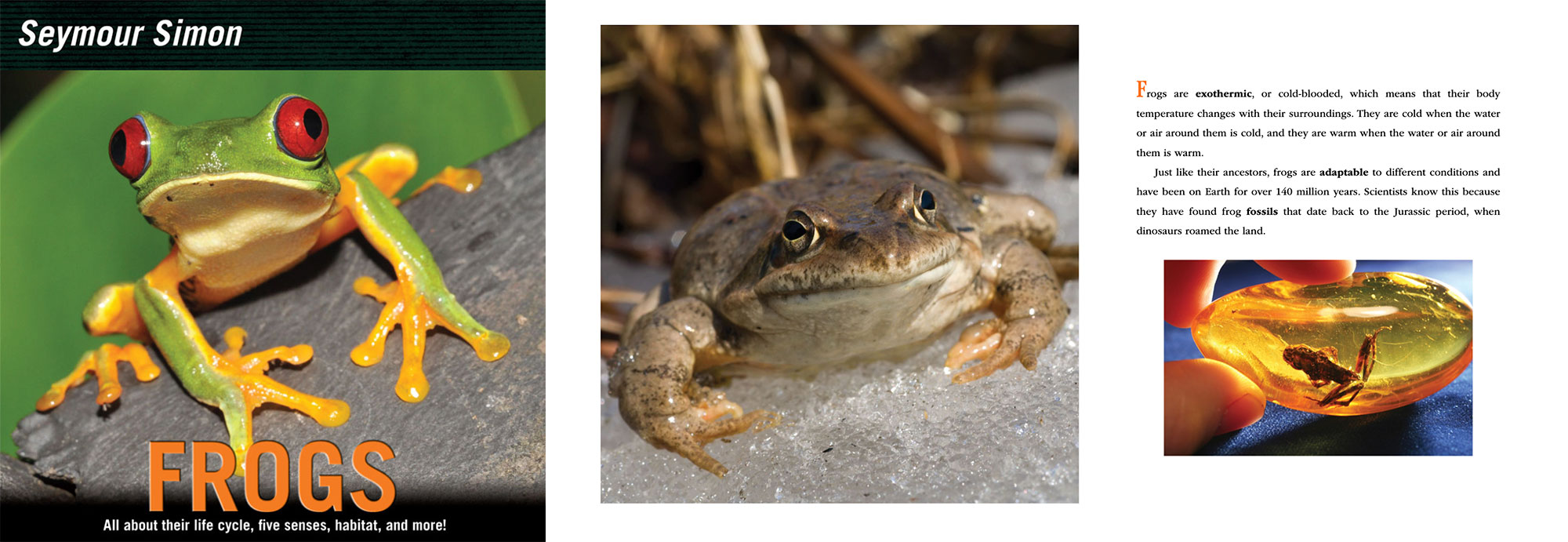
Cover and page spread from Frogs by Seymour Simon (HarperCollins).
Signal words, phrases, and questions
| Characteristic | Location | Appearance | Signal Questions |
|---|---|---|---|
| for example | in front of | looks like | What (things, people, events, components or steps) are described? |
| for instance | beside | seems | What does it look like? |
| such as | near | appears | What does it do? |
| is like | next to | gives the appearance of | How does it work? |
| including | on top of | ||
| to illustrate | below | ||
| behind |
Cause and effect
The cause and effect text structure tells why something happened (cause) and what happened (effect).
Examples: A book about weather shows how specific weather patterns can cause extreme weather such as a blizzard or a hurricane. A book about volcanoes describes how eruptions occur when an opening develops in the Earth’s crust and the molten (magma) is forced through the crack.

Cover and pages from Volcanoes by Gail Gibbons (Holiday House)
Signal words, phrases, and questions
| Signal Words or Phrases | Signal Questions |
|---|---|
| because | What happened? |
| as a result | What caused it to happen? |
| therefore | Why did it happen? |
| consequently | |
| hence | |
| thus | |
| for this reason | |
| due to |
Compare and contrast
The compare and contrast text structure examines the similarities and differences between two or more people, events, concepts, and ideas.
Examples: A book about ancient Greece explains how the Spartan women were different from the Athenian women. A book about moths and butterflies describes how they are similar and how they are different.
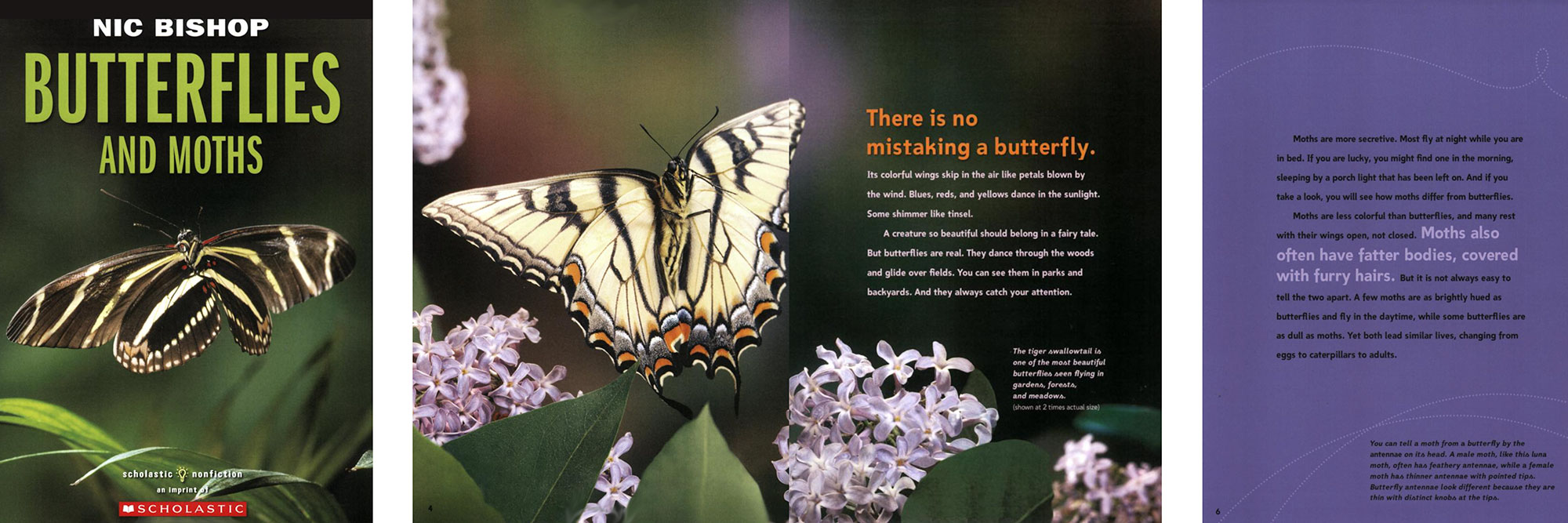
Cover and pages from Butterflies and Moths by Nic Bishop (Scholastic)
Signal words, phrases, and questions
| Compare | Contrast | Signal Questions |
|---|---|---|
| like | differ | What is being compared? |
| alike | but | How are they the same? |
| both | in contrast to | How are they different? |
| also | however | |
| similar | on the other hand | |
| too | unlike | |
| just like | ||
| just as |
Chronology/sequence
The chronology/sequence text structure describes items or events in order, or explains the steps to follow.
Examples: A book about the American revolution lists the events leading to the war. A book about bees explains how bees make honey.
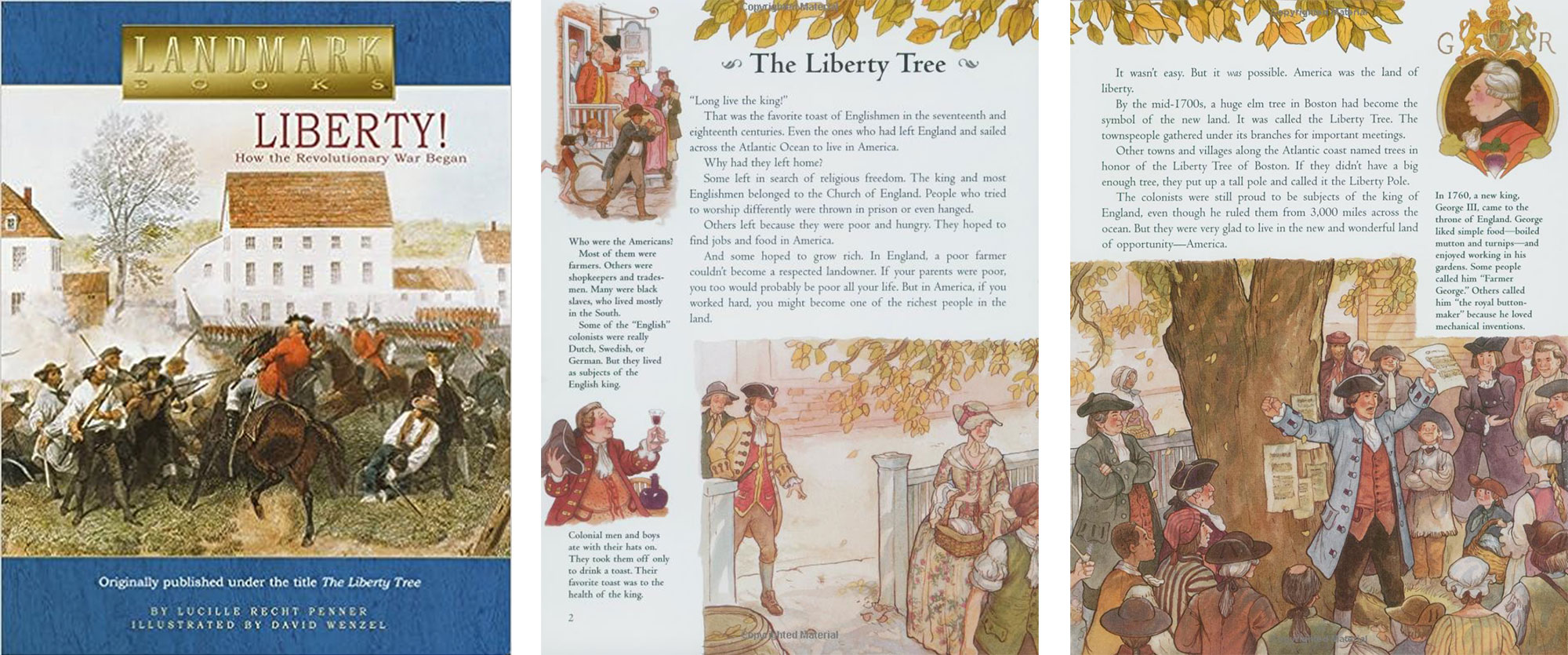
Cover and pages from Liberty! How the Revolutionary War Began by Lucille Recht Penner (Random House)
Signal words, phrases, and questions
| Signal Words or Phrases | Signal Questions |
|---|---|
| first, second, third, etc. | What happened first, next, last? |
| next | What order or sequence did the author tell you about the people, events, or steps? |
| then | Do they have to happen in this order? |
| finally | |
| after | |
| before | |
| during | |
| while | |
| when |
Problem and solution
The cproblem and solution text structure sets up a problem or problems, explains the solution, and then discusses the effects of the solution.
Example: A book about climate change explains what causes it and what we can do to reverse the dangers.
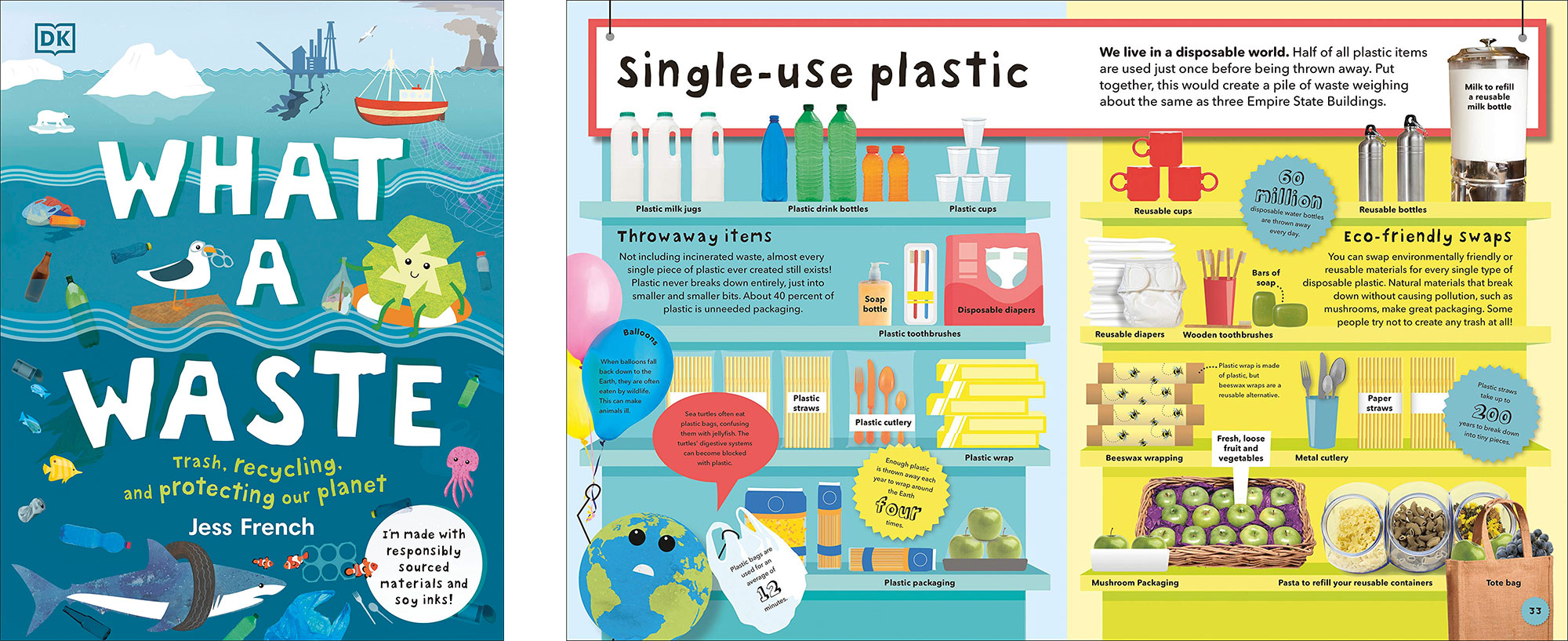
Cover and page spread from What a Waste: Trash, Recycling, and Protecting our Planet by Jess French (DK Publishing).
Signal words, phrases, and questions
| Signal Words or Phrases | Questions and Answers | Signal Questions |
|---|---|---|
| problem is | who | What is the problem here? |
| dilemma is | what | Why is this a problem? |
| solution is | why | Does the author describe a solution? |
| one solution is | where | Is anything being done to try to solve the problem? |
| another solution is | when | What are some possible solution/s |
| to solve the problem | how | |
| in order to solve the problem | which | |
| do you know |
Download all templates
Download the complete set of text structure templates to help students learn how to write using different patterns of organization.
Basic steps in teaching text structure
Before reading
- Choose the assigned reading and introduce the text to the students.
- Introduce the idea that texts have organizational patters called text structures.
- Introduce the following common text structures (see the chart below for more detailed information)
During and after reading
- Show examples of paragraphs that correspond to each text structure.
- Examine topic sentences and other text signals that clue the reader to a specific structure.
- Model the writing of a paragraph that uses a specific text structure.
- Have students try write paragraphs that follow a specific text structure.
- Have students diagram these structures using a graphic organizer.
Additional tips for understanding text structure
- Pay attention to the title and headings. These often give clues about the text structure.
- Think about the purpose of the text. What is the author trying to communicate?
- Ask yourself questions. What are the main points of the text? How are the ideas connected?
Researchers Kausalai (Kay) Wijekumar and Andrea L. Beerwinkle have developed and tested a powerful, effective text structure strategy. Their method begins with the comparison text structure, followed by cause and effect and problem and solution. Sequence and description are left to the end and not taught in as much detail because students are more familiar with these structures. Learn more: Implementing the Text Structure Strategy in Your Classroom
Featured video
Learn more about teaching text structure
Comprehension
Reading (and Scaffolding) Expository Texts
Background Knowledge
Five Kinds of STEM-themed Nonfiction Books for Kids
Shanahan on Literacy
